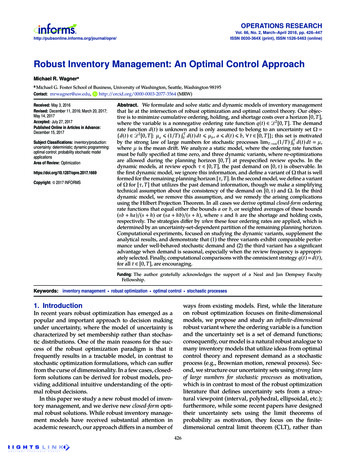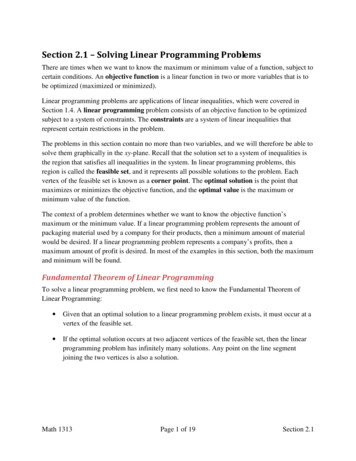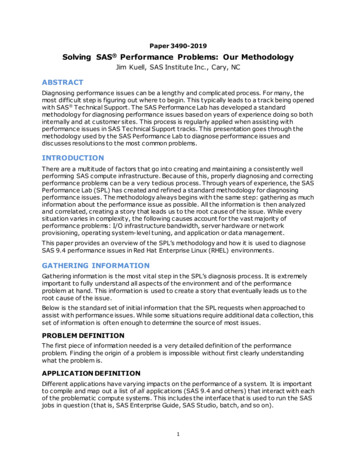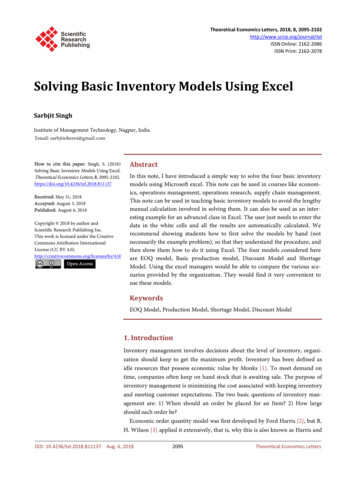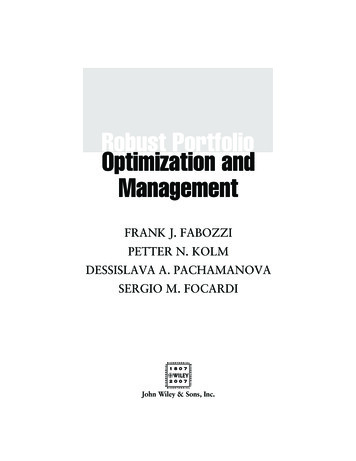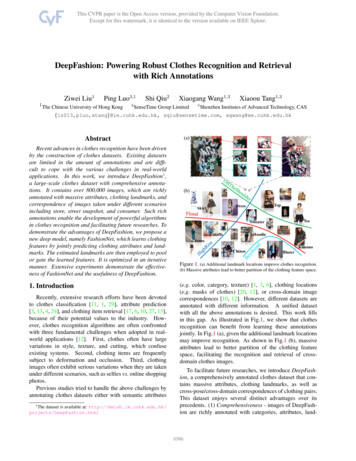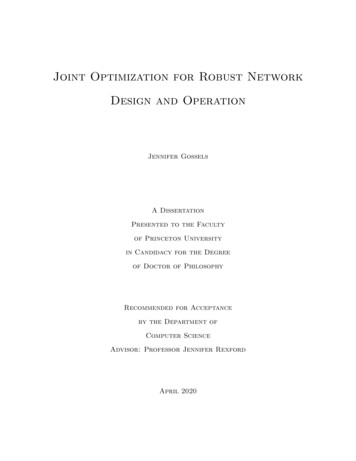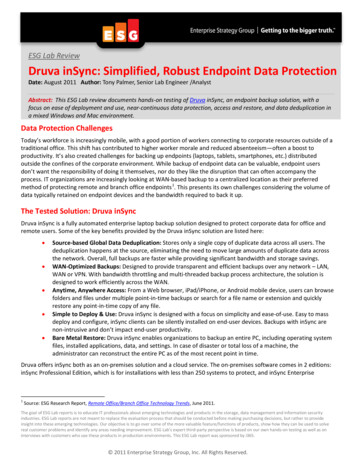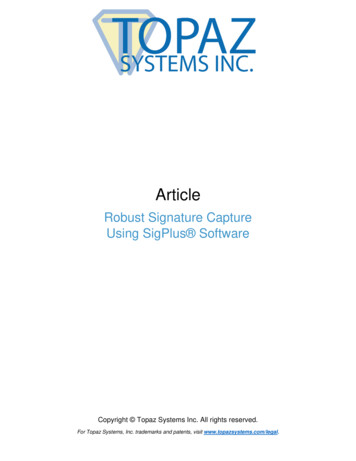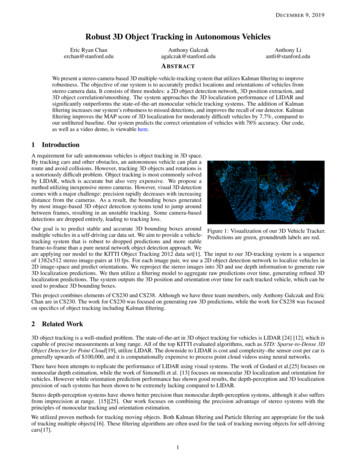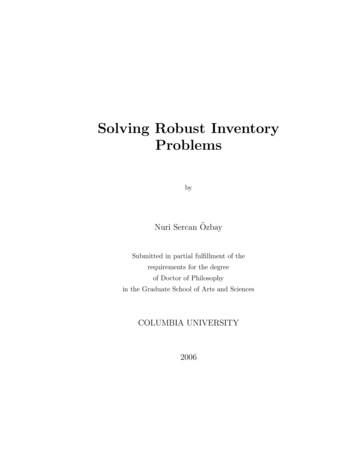
Transcription
Solving Robust InventoryProblemsbyNuri Sercan ÖzbaySubmitted in partial fulfillment of therequirements for the degreeof Doctor of Philosophyin the Graduate School of Arts and SciencesCOLUMBIA UNIVERSITY2006
ABSTRACTSolving Robust Inventory ProblemsIn this work we consider setting the optimal inventory control policies for a singlebuffer when demand is uncertain, in a robust framework. Unlike traditional inventorymodels we do not assume that the demand is random with a known distribution.Instead, demand can take values from a given uncertainty set. Our objective is tofind the policy that minimize the maximum cost that is attainable by the demandvectors in our uncertainty set. We consider the problem for two different types ofpolicies which are very common in practice and present a family of algorithms basedon decomposition that scale well to problems with hundreds of time periods. We alsopresent theoretical results on more general models.
Contents1 Introduction11.1Literature review . . . . . . . . . . . . . . . . . . . . . . . . . . . . .21.2Our model and contributions . . . . . . . . . . . . . . . . . . . . . . .61.2.11.3Generic algorithm . . . . . . . . . . . . . . . . . . . . . . . . .11Notation . . . . . . . . . . . . . . . . . . . . . . . . . . . . . . . . . .142 The Static Problem152.1Prior work . . . . . . . . . . . . . . . . . . . . . . . . . . . . . . . . .162.2Demand uncertainty . . . . . . . . . . . . . . . . . . . . . . . . . . .222.3The decision maker’s problem . . . . . . . . . . . . . . . . . . . . . .232.4The adversarial problem under the risk budgets model . . . . . . . .242.4.1A special case . . . . . . . . . . . . . . . . . . . . . . . . . . .292.4.2The adversarial problem as a mixed-integer program . . . . .312.5The adversarial problem in the bursty demand model . . . . . . . . .332.6Computational results for the static problem . . . . . . . . . . . . . .34i
3 The Basestock Problem393.1Preliminaries . . . . . . . . . . . . . . . . . . . . . . . . . . . . . . .423.2The decision maker’s problem . . . . . . . . . . . . . . . . . . . . . .443.3The adversarial problem under the risk budgets model . . . . . . . .483.3.1Handling M. . . . . . . . . . . . . . . . . . . . . . . . . . . . .533.3.2Handling B. . . . . . . . . . . . . . . . . . . . . . . . . . . . .543.3.3Handling F . . . . . . . . . . . . . . . . . . . . . . . . . . . .583.3.4The algorithm . . . . . . . . . . . . . . . . . . . . . . . . . . .583.3.5The approximate adversarial algorithm . . . . . . . . . . . . .603.3.6Integral budgets case . . . . . . . . . . . . . . . . . . . . . . .623.3.7A bounding procedure for the risk budgets model . . . . . . .633.4The adversarial problem under the bursty demand model . . . . . . .643.5Experiments with the basestock model . . . . . . . . . . . . . . . . .683.5.1The risk budgets model . . . . . . . . . . . . . . . . . . . . . .683.5.2The bursty demand model . . . . . . . . . . . . . . . . . . . .74Extensions . . . . . . . . . . . . . . . . . . . . . . . . . . . . . . . . .803.6.1Polyhedral uncertainty sets. . . . . . . . . . . . . . . . . . .803.6.2Robust safety stocks . . . . . . . . . . . . . . . . . . . . . . .813.6.3Ambiguous uncertainty sets . . . . . . . . . . . . . . . . . . .883.6.4Model superposition . . . . . . . . . . . . . . . . . . . . . . .913.6.5More comprehensive supply-chain models . . . . . . . . . . . .933.6ii
3.7Summary of the results . . . . . . . . . . . . . . . . . . . . . . . . . .4 The Dynamic Problem93954.1Preliminaries . . . . . . . . . . . . . . . . . . . . . . . . . . . . . . .4.2Characterization of optimal policies . . . . . . . . . . . . . . . . . . . 1014.3Risk budgets model . . . . . . . . . . . . . . . . . . . . . . . . . . . . 1044.3.14.498A special case . . . . . . . . . . . . . . . . . . . . . . . . . . . 106Bursty demand model . . . . . . . . . . . . . . . . . . . . . . . . . . 107Appendices109A An alternative approach for solving PM109B NP-completeness proofs116B.1 Proof of Theorem 3.4.1 . . . . . . . . . . . . . . . . . . . . . . . . . . 116B.2 Proof of Theorem 3.6.1 . . . . . . . . . . . . . . . . . . . . . . . . . . 119C Algorithms for the discrete budgets model121C.1 Proof of Theorem 3.6.4 . . . . . . . . . . . . . . . . . . . . . . . . . . 121C.2 Proof of Theorem 3.6.5 . . . . . . . . . . . . . . . . . . . . . . . . . . 126iii
List of Figures2.1Example with many steps . . . . . . . . . . . . . . . . . . . . . . . .383.1% error in basestock vs. % error in cost . . . . . . . . . . . . . . . . .743.2Effect of scaling peaks on optimum basestock79iv. . . . . . . . . . . . .
List of Tables2.1Solving the adversarial problem as a mixed-integer program . . . . .322.2Parameters for data generation . . . . . . . . . . . . . . . . . . . . .352.3Running time and number of iterations . . . . . . . . . . . . . . . . .372.4Running time and number of iterations for the budgets model . . . .383.1Performance of algorithm for risk budgets (T 100). . . . . . . . . .693.2Error in the basestock produced by using early termination. . . . . .693.3Performance statistics – integral budgets . . . . . . . . . . . . . . . .703.4Ratio of adversarial time to total running time for the budgets model713.5Static vs Basestock Policies . . . . . . . . . . . . . . . . . . . . . . .723.6% increase in average cost of dynamic and static policies over the rollinghorizon basestock policy . . . . . . . . . . . . . . . . . . . . . . . . .3.73.873Behavior of algorithm for bursty demand model under a constant basestock . . . . . . . . . . . . . . . . . . . . . . . . . . . . . . . . . . . .75Impact of window size on a 300-period model . . . . . . . . . . . . .76v
3.9Impact of initial inventory . . . . . . . . . . . . . . . . . . . . . . . .773.10 Variance vs Optimal Basestock . . . . . . . . . . . . . . . . . . . . .79vi
CHAPTER 1. INTRODUCTION1Chapter 1IntroductionDesigning an efficient supply chain and operating it efficiently is one of the most important issues for a large number of modern organizations. For the past three decades,increasing economic and competitive pressure has forced manufacturers to create better ways to control every single step in their supply chain, from supplier contracts todistribution channels. Due to recent fluctuations in the economy, matching supply todemand has become even more challenging. Nowadays, there is a growing need formore robust supply chains that are responsive to the changes in market conditions.This work was inspired by a project carried out with an industrial partner and it concerns the optimal stock ordering policies for a buffer in a supply chain in an uncertainenvironment.
CHAPTER 1. INTRODUCTION1.12Literature reviewThe origins of Supply Chain/Inventory Management can be found as early as thebeginning of 20th century when Harris [H13] derived the Economic-Order-Quantityformula that applies when the demand is assumed to be constant over time. Overthe few decades preceding his work numerous authors elaborated different variationsof Harris’ EOQ model. Although pioneers of the field were aware of the uncertaintiesassociated with the problem, the study of the problem in a stochastic setting wasonly started in the 1950’s, with the seminal papers by Arrow, Harris and Marschak[AHM51] and Dworetzky, Kiefer and Wolfowitz [DKW52]. Since then, supply chainoptimization problems have been studied extensively under stochastic settings usingdifferent methodologies such as dynamic programming and stationary analysis. Werefer the reader to Zipkin [Z00] for a comprehensive discussion of various models insupply chain/inventory management.One of the most important advancements in supply chain management took placewhen Clark and Scarf [CS60] proved the optimality of basestock policies for serial systems using dynamic programming, a powerful technique that would later be used bymany other authors to derive structural results about optimal inventory control policies. Subsequently, basestock policies became increasingly popular and were provedto be optimal for many other inventory models. For further work on basestock policies see Iglehart [I63a, I63b], Veinott [V66], Ehrhart [E84] and Muharremoglu and
CHAPTER 1. INTRODUCTION3Tsitsiklis [MT01]. While such a policy is not necessarily optimal, it may be preferableover optimal policies since it is easy to implement and often performs very well. Dueto its simplicity it is widely used in practice and finding optimal basestock levels itselfhas drawn a lot of attention by both practitioners and researchers.Traditional models for supply chain management are often criticized by practitioners for their strong assumptions, among which is full knowledge of the underlyingdemand distribution. In most real world applications, especially in industries withshort product life cycles, paucity of historical demand data makes it very hard todetermine a demand distribution that fits the observed data. In such situations theinventory controller should make decisions using partial information, such as inaccurate forecasts, about future demand, and estimates for the error in these forecasts.To the best of our knowledge the first work on distribution free supply chainmanagement problems is due to Scarf [S58] who considered a single period newsvendorproblem and determined the orders that maximize the minimum expected profit overall possible demand distributions for given first and second moments. Later, Gallegoand Moon [GM93, MG94] provided concise derivations of his results and extendedit to other cases. Gallego, Ryan and Simchi-Levi [GRS01] considered the multiperiod version of this problem with discrete demand distribution and proved theoptimality of basestock policies. Recently, Bertsimas and Thiele [BT04] and Ben-Talet. al. [BGNV05] studied some supply chain management problems with limiteddemand information using the robust optimization framework. The central difference
CHAPTER 1. INTRODUCTION4of their work from previous work is that instead of assuming partial information aboutthe distribution of the demand, they assume that uncertain demand is explicitlyrepresented by a set that defines all possible demand values. In Chapter 2 we providea detailed discussion of their results. Also see [BGGN04] and [T05].Robust Optimization is an increasingly accepted way to handle uncertainty. Itaddresses parameter uncertainties in deterministic optimization problems. UnlikeStochastic Programming it does not assume that the uncertain parameters are randomvariables with known distributions, instead it represents uncertainty in parametersusing deterministic uncertainty sets in which all possible values of these parametersreside. Typically, Robust Optimization adopts a min-max approach that guarantees the feasibility of the obtained solution for all possible values of the uncertainparameters in the given uncertainty sets.Although the underlying ideas are older, the classical references for Robust Optimization are Ben-Tal and Nemirovski [BN98, BN99, BN00] where they studied agroup of convex optimization problems with uncertain parameters and showed thatthey can be formulated as conic programs which can be solved in polynomial time.Since then, there has been a large amount of research dealing with various aspects ofRobust Optimization. For example, Bertsimas and Sim [BS03] proposed a new polyhedral uncertainty set that guarantees feasibility with high probability for generaldistributions for the uncertain parameters. They show that Linear Programs withthis uncertainty framework can be reformulated as Linear Programs with a small
CHAPTER 1. INTRODUCTION5number of additional variables. Also see [AZ05], where robustness is introduced inthe context of a combinatorial optimization problem.Robust Optimization methodology was originally developed to deal with staticproblems in which all of the decision variables are set prior to resolution of any uncertainty. However, in most real life applications, the dynamic nature of the problemsallows decision makers to revise their decisions as more information about the uncertain parameters becomes available. This is especially true for multi-period decisionmaking problems where static robust optimization models are unable to capture thefact that the decision maker knows the values of uncertain parameters in the preceding periods and can exploit this information when making his decisions. Recognizingthe need for incorporating the dynamic nature of the multi-period decision makingproblems into Robust Optimization models, Ben-Tal et. al. [BGGN04], recentlyproposed Affinely Adjustable Robust Counterpart models which feature the idea ofdynamically determining decision variables as affine functions of the portion of theuncertain data that has been realized. By restricting the decisions to affine functions of the past data they managed to produce tractable formulations for uncertainLinear Programs. Ben-Tal et. al. [BGNV05] applied these ideas to a supply chainmanagement problem to get a polynomial time solvable formulation. We will reviewthis work more closely in Section 2.1.Another field that deals with uncertainty in optimization problems is AdversarialQueuing, which was first considered by Borodin et. al [BKRSW96]. They studied
CHAPTER 1. INTRODUCTION6packet routing over queuing networks when there is only limited information aboutdemand. Following an approach similar to Robust Optimization, they adopted aworst case approach and proved some stability results that holds for all realizationsof the demand. They used a demand model that is first introduced by Cruz [C91] tocapture the burstiness of inputs in communication networks. Later, Andrews et. al.[AAFKLL96] considered a similar problem with different network protocols.1.2Our model and contributionsIn this thesis we develop procedures for setting the stock ordering policies for a bufferin a supply chain subject to uncertainty in the demands.
Solving Robust Inventory Problems In this work we consider setting the optimal inventory control policies for a single bu er when demand is uncertain, in a robust framework. Unlike traditional inventory models we do not assume that the demand is random with a known distribution. Instead, demand can take values from a given uncertainty set. Our objective is to
